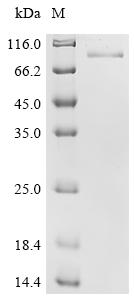Our Recombinant Mouse Growth arrest-specific protein 6 (Gas6) is expressed in a mammalian cell system, which appears to ensure proper post-translational modifications. The protein contains the full length of the mature sequence, spanning amino acids 28 to 674, and includes a C-terminal 10xHis-tag for easier purification and detection. Purity levels exceed 95% as verified by SDS-PAGE. This makes it what seems to be a reliable reagent for research applications.
Gas6 likely plays a crucial role in cell signaling and participates in various cellular processes, including cell survival, proliferation, and migration. It acts as a ligand for the TAM family of receptor tyrosine kinases, which appear significant in regulating immune responses and maintaining cellular homeostasis. Researchers have extensively studied Gas6 for its involvement in hemostasis and inflammation, suggesting it's an important protein in scientific research.
Potential Applications
Note: The applications listed below are based on what we know about this protein's biological functions, published research, and experience from experts in the field. However, we haven't fully tested all of these applications ourselves yet. We'd recommend running some preliminary tests first to make sure they work for your specific research goals.
Mammalian cells provide an optimal environment for proper folding, disulfide bond formation, and post-translational modifications (e.g., glycosylation) required for Gas6's bioactivity, including binding to TAM receptors (Ax1, Tyro3, Mer) and mediating cellular signaling. The C-terminal His tag is unlikely to significantly interfere with functional domains. The high purity indicates low impurities. However, without experimental validation (e.g., receptor binding assays or cell-based functional tests), the protein cannot be assumed to be correctly folded or bioactive, though the expression system suggests a high probability of native conformation.
1. Protein-Protein Interaction Studies via His-Tag Pull-Down Assays
The His tag enables pull-down assays to identify binding partners (e.g., TAM receptors). However, if Gas6 is misfolded, interactions may be non-physiological. Validate any identified partners using native Gas6 from mouse sources or confirm binding with functional assays (e.g., SPR). The high purity reduces background but does not guarantee physiological relevance without folding validation.
2. Antibody Development and Validation
This application is suitable. The recombinant Gas6 can serve as an immunogen for generating antibodies, as mammalian expression likely preserves native epitopes. The high purity supports consistent immunization. However, validate antibody specificity against endogenous Gas6 in mouse tissues or cell lysates to ensure recognition of physiological conformations.
3. Biochemical Characterization and Protein Stability Studies
This recombinant mouse Gas6 is suitable for biophysical analysis (e.g., thermal stability, oligomerization via SEC-MALS). The high purity allows accurate measurements. However, data may be influenced by the His tag; compare with tag-free Gas6 if possible. These studies can proceed without activity validation but may not fully reflect native behavior if misfolded.
4. His-Tag Based ELISA Development
This recombinant mouse Gas6 is feasible for developing ELISA assays, as the His tag facilitates immobilization. However, if Gas6 is misfolded, the assay may not accurately quantify native Gas6 in samples. Validate the ELISA with native Gas6 standards to ensure correlation with physiological levels.
Final Recommendation & Action Plan
Before using this recombinant Gas6 for functional studies, validate its folding and bioactivity through receptor binding assays (e.g., with Ax1-Fc) or cell-based signaling assays (e.g., phosphorylation of Akt). If active, proceed with interaction or ELISA studies; if inactive, limit use to non-functional applications like antibody production (with validation against native Gas6). For biochemical characterization, use directly, but interpret results cautiously. Always include controls with native Gas6 to ensure biological relevance. The mammalian expression system supports high-quality production, but experimental confirmation remains essential.






